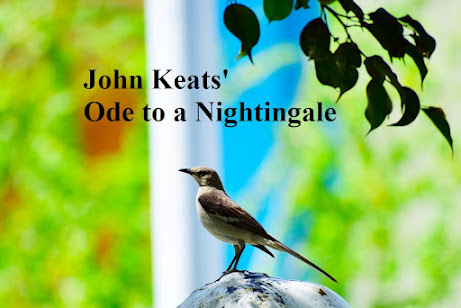"Ode to a Nightingale" is one of the most celebrated poems of John Keats, a leading figure of the Romantic movement in English literature. The poem is marked by its rich sensory imagery, its intense lyricism, and its exploration of themes of transience, mortality, and the power of the imagination. Below is a critical study of the poem:
1. Structure: The poem is divided into eight stanzas, each comprising ten lines. The rhyme scheme is ABABCDECDE, with the first and third lines of each stanza rhyming with each other. The poem is written in iambic pentameter, with each line consisting of five pairs of unstressed and stressed syllables. The structure of the poem is relatively formal, with a regular pattern of meter and rhyme, but the language is highly imaginative and emotive, creating a tension between form and content.
2. Imagery: The poem is characterized by its rich sensory imagery, which evokes the sights, sounds, and smells of the natural world. The nightingale's song is described as a "full-throated ease" that fills the air with its "rich unrest". The speaker imagines himself as a "swallow" chasing the nightingale through the skies, and describes the nightingale's voice as a "light-winged Dryad of the trees". The poem also contains vivid descriptions of the natural world, such as the "drowsy numbness" of the poppies and the "embalmed darkness" of the yew-tree.
3. Themes: The poem explores a number of key themes, including the transience of human life, the power of the imagination, and the relationship between human beings and the natural world. The nightingale's song represents a realm of eternal beauty and joy that is inaccessible to human beings, and the speaker longs to escape from the transience of his own life into this realm of immortality. The poem also celebrates the transformative power of the imagination, which can transport the speaker beyond the limitations of his own mortal existence and into a realm of beauty and joy. The poem is deeply attuned to the beauty of the natural world, and the nightingale's song represents a kind of communion with nature that is capable of transcending the limitations of human experience.
4. Tone: The tone of the poem is one of intense emotion, marked by a sense of melancholy and longing. The speaker is deeply moved by the nightingale's song, which evokes a sense of rapture and ecstasy, but he is also aware of the limitations of his own mortality and the inevitability of death. The poem captures the Romantic longing for escape and transcendence while also acknowledging the limitations of this impulse and the necessity of accepting the transience of human life.
In conclusion, "Ode to a Nightingale" is a powerful and evocative poem that explores some of the key themes and concerns of the Romantic movement in English literature. The poem is marked by its rich sensory imagery, its intense lyricism, and its exploration of themes of transience, mortality, and the power of the imagination. The poem continues to resonate with readers today as a testament to the enduring power of poetry to capture the beauty and complexity of human experience.

No comments:
Post a Comment